Thevenin Theorem Assignment Help
Thevenin theorem Assignment Help
www.assignmenthelp.net provides Thevenin theorem Assignment Help, electrical engineering homework help or electrical engineering Assignment Help. We provide every kind of online tutoring assistances. Submit your homework to us to get help in any kind of homework. We are available 24*7. We provide 100% plagiarism free service.
Thevenin Theorem Tutor
We have highly professional tutors and an excellent team for teaching Thevenin theorem and its problems. Tutors for this topic are electrical engineers with masters and PHD degrees. They use latest advanced technologies to teach different difficult concepts to students. Tutors use such teaching methodologies so that students gain maximum interest in the subject.

Thevenin Theorem
Thevenin theorem states that any linear electrical network with only resistances, voltage sources and current sources can be replaced at end terminals (A-B) by an equivalent voltage source Vth in series with an equivalent resistance Rth. The equivalent voltage Vth is the voltage obtained at the end terminal A-B when we keep the circuit terminals A-B open circuited. Equivalent resistance Rth is the resistance obtained at end terminals A-B when all the independent voltage sources are short circuited and all the independent current sources are open circuited. For AC systems, this theorem is applied to resistances as well as reactive impedances.

fig (1): Thevenin Equivalent circuit
To calculate the equivalent circuit two equations are required because resistance and voltage are needed. We get the two equations by using following steps: first calculate the output voltage VAB when the circuit is in open circuit condition. This is known as VTh. Then calculate the output current IAB, when output terminals are short circuited. RTh = VTh / IAB. The final equivalent circuit is a voltage source VTh in series with resistance RTh. We can also think of step 2 as: replace the independent voltage source with short circuit and independent current source with open circuits. Then calculate the resistance between terminals A and B which is actually RTh.
The equivalent Thevenin voltage is the voltage at the output terminals of original circuit. The equivalent Thevenin resistance is the resistance measured across point A and B “looking back” into the circuit. When we calculate the equivalent Thevenin voltage, the voltage divider principle is useful, by declaring one terminal to be at ground point and other terminal to be at Vout. We replace all the voltage and current sources with their internal resistances. For an ideal current source, this means replace the current source with an open circuit. For an ideal voltage source, this means replace the voltage source with a short circuit. Then by using the formula for series and parallel circuits, resistance can then be calculated across the terminals. In case there are dependent sources in the circuit, another method must be used such as connecting a test source across A and B and calculating the current through the test source or calculating the voltage across.
Thevenin Theorem Example
Let's take a look at our example circuit:
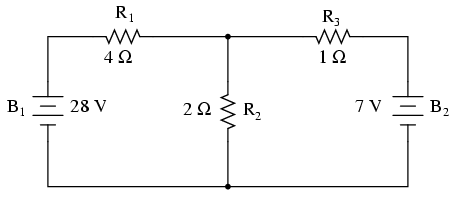
We decide to take R2 as the “load” resistor in this circuit. Thevenin’s theorem helps in solving the circuit by temporarily removing load resistance from the original circuit and then reduce the left circuit to its thevenin’s equivalent circuit which is a single voltage source and a series resistance. Then we add the load resistance in series with the thevenin equivalent circuit and then we solve the circuit as if it was a simple series circuit:
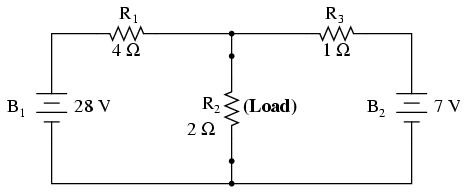
. . . after Thevenin conversion . . .
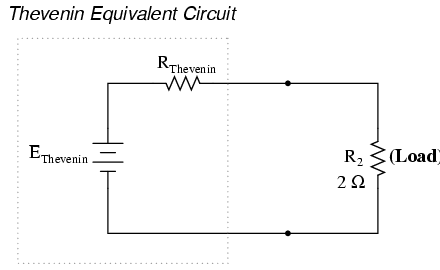
The “Thevenin Equivalent Circuit” is the electrical equivalent of B1, R1, R3 and B2 as seen from the two points where our load resistor (R2) connects.The Thevenin equivalent circuit behaves exactly the same as the original circuit formed by B1, R1, R3 and B2. First, the chosen load resistor is removed from the original circuit, replaced with a break (open circuit):
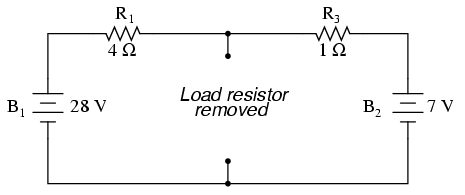
Next, the voltage, current and total resistance between the two points where the load resistor used to be attached is determined using Ohms law and KVL (Kirchoff's Voltage law):
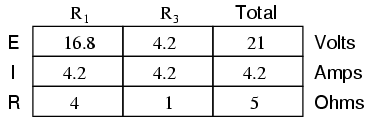

The voltage between the load connection points is the “Thevenin voltage” (EThevenin) in the equivalent circuit:
Thevenin Theorem Assignment Help Through Online Tutoring and Guided Sessions from AssignmentHelp.Net
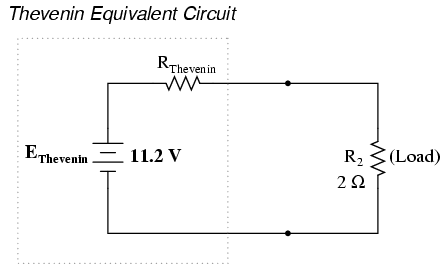
To find the Thevenin series resistance for our equivalent circuit, we take the original circuit (with the load resistor still removed), remove the power sources, replace the voltage sources with wires and calculate the resistance from one load terminal to the other:
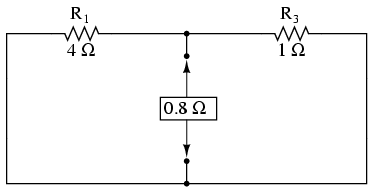
The total resistance from one load terminal to another is equal to R1 and R3 in parallel: 0.8 Ω. This is our “Thevenin resistance” (RThevenin) for the equivalent circuit:
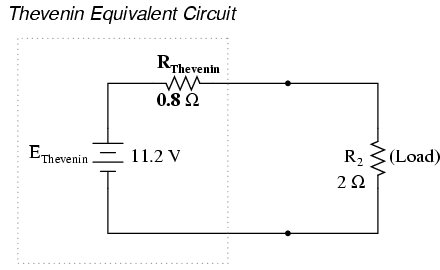
Now we add load resistor (2 Ω) between the connection points and calculate current and voltage in the circuit.
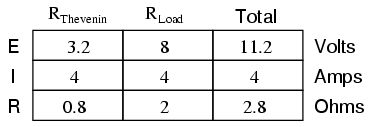
Hence we get the voltage and current (8 volts, 4 amps) across the load resistance. Notice that equivalent thevenin resistance and equivalent thevenin voltage do not apply to any other component in the original circuit. They are only meant for determining the current and voltage across the load resistance.


